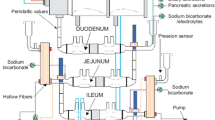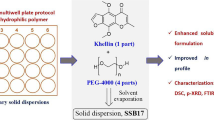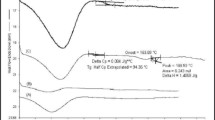Abstract
Purpose
Whey protein isolate (WPI) has previously been shown to be a promising new excipient for the development of amorphous solid dispersions (ASD) at a high drug loading of 50% (w/w). Whilst WPI is a protein mixture, comprising mainly the three proteins β-lactoglobulin (BLG), α-lactalbumin (ALA), casein glycomacropeptides (CGMP), the individual contributions of these three proteins to the overall performance of whey protein based ASDs has still not been investigated. In addition, the limitations of the technology at even higher drug loadings (i.e., more than 50%) have not yet been explored. In this study, BLG, ALA, CGMP and WPI were each prepared as ASDs with the two poorly water-soluble drugs (Compound A and Compound B) at 50%, 60% and 70% drug loadings.
Methods
Solid state characterization, dissolution rate and physical stability of the obtained samples were analyzed.
Results
All the obtained samples were amorphous and showed faster dissolution rates compared to the respective pure crystalline drugs. However, the BLG based formulations—at least for Compound A—were outperforming the other ASDs in terms of stability, dissolution enhancement and solubility increase.
Conclusion
Overall, the study confirmed that the investigated whey proteins showed their potential in developing ASDs even at high drug loadings of up to 70%.




Similar content being viewed by others
References
Brough C, Williams RO. Amorphous solid dispersions and nano-crystal technologies for poorly water-soluble drug delivery. Int J Pharm. 2013;453(1):157–66. https://doi.org/10.1016/j.ijpharm.2013.05.061.
Grohganz H, et al. Refining stability and dissolution rate of amorphous drug formulations. Expert Opin Drug Deliv. 2014;11(6):977–89. https://doi.org/10.1517/17425247.2014.911728.
Moseson DE, Ning T, Su Y, Taylor LS. Formulation and processing strategies which underpin susceptibility to matrix crystallization in amorphous solid dispersions. J Pharm Sci. 2023;112(1):108–22. https://doi.org/10.1016/j.xphs.2022.03.020.
Bhattacharya S, Suryanarayanan R. Local mobility in amorphous pharmaceuticals-Characterization and implications on stability. J Pharm Sci. 2009;98(9):2935–53. https://doi.org/10.1002/jps.21728.
Yu L. Amorphous pharmaceutical solids: preparation, characterization and stabilization. Adv Drug Deliv Rev. 2001;48:27–42. https://doi.org/10.1016/S0169-409X(01)00098-9.
Sandhu H, Shah N, Chokshi H, Malick AW. Overview of amorphous solid dispersion technologies. Amorphous solid dispersions: theory and practice. Springer, New York. 2014;91–122.
He Y, Ho C. Amorphous solid dispersions: utilization and challenges in drug discovery and development. J Pharm Sci. 2015;104(10):3237–58. https://doi.org/10.1002/jps.24541.
Démuth B, et al. Downstream processing of polymer-based amorphous solid dispersions to generate tablet formulations. Int J Pharm. 2015;486(1–2):268–86. https://doi.org/10.1016/j.ijpharm.2015.03.053.
Madureira AR, Pereira CI, Gomes AM, Pintado ME, Malcata FX. Bovine whey proteins-Overview on their main biological properties. Food Res. 2007;40:1197–1211. https://doi.org/10.1016/j.foodres.2007.07.005.
Morr CV, Ha EYW. Whey protein concentrates and isolates: processing and functional properties. Crit Rev Food Sci Nutr. 1993;33(6):431–76. https://doi.org/10.1080/10408399309527643.
Farooq MA, et al. Whey protein: a functional and promising material for drug delivery systems recent developments and future prospects. Polym Adv Technol. 2019;30(9):2183–91. https://doi.org/10.1002/pat.4676.
Liu W, Chen XD, Cheng Z, Selomulya C. On enhancing the solubility of curcumin by microencapsulation in whey protein isolate via spray drying. J Food Eng. 2016;169:189–95. https://doi.org/10.1016/j.jfoodeng.2015.08.034.
MaHam, A, Tang, Z, Wu H, Wang J, Lin Y. Protein‐based nanomedicine platforms for drug delivery. Small. 2009;5(15):1706–21. https://doi.org/10.1002/smll.200801602.
Li M, Ma Y, Cui J. Whey-protein-stabilized nanoemulsions as a potential delivery system for water-insoluble curcumin. LWT Food Sci Technol. 2014;59(1):49–58. https://doi.org/10.1016/j.lwt.2014.04.054.
Allahdad Z, Varidi M, Zadmard R, Saboury AA, Haertlé T. Binding of β-carotene to whey proteins: Multi-spectroscopic techniques and docking studies. Food Chem. 2019;277(May 2018):96–106. https://doi.org/10.1016/j.foodchem.2018.10.057.
Mishra J, Bohr A, Rades T, Grohganz H, Löbmann K. Whey proteins as stabilizers in amorphous solid dispersions. Eur J Pharm Sci. 2019;128(November 2018):144–151. https://doi.org/10.1016/j.ejps.2018.12.002.
Bates S, Zografi G, Engers D, Morris K, Crowley K, Newman A. Analysis of amorphous and nanocrystalline solids from their X-ray diffraction patterns. Pharm Res. 2006;23(10):2333–49. https://doi.org/10.1007/s11095-006-9086-2.
Acknowledgements
We thank Arla Foods Ingredients Group P/S for providing the samples of Lacprodan® BLG Pharma Grade, alpha-lactalbumin and Lacprodan® CGMP-20 and whey protein isolate.
Author information
Authors and Affiliations
Corresponding author
Ethics declarations
Conflict of Interest
Donglei Leng, Bulut Bulduk, Ole Wiborg and Korbinian Löbmann are employees at Zerion Pharma A/S, who is developing a technology based on the subject matter or materials discussed in this manuscript.
Additional information
Publisher's Note
Springer Nature remains neutral with regard to jurisdictional claims in published maps and institutional affiliations.
Rights and permissions
Springer Nature or its licensor (e.g. a society or other partner) holds exclusive rights to this article under a publishing agreement with the author(s) or other rightsholder(s); author self-archiving of the accepted manuscript version of this article is solely governed by the terms of such publishing agreement and applicable law.
About this article
Cite this article
Leng, D., Bulduk, B., Widmer, T. et al. Protein Based Amorphous Solid Dispersion: a Case Study Investigating Different Whey Proteins at High Drug Loading. Pharm Res 40, 1865–1872 (2023). https://doi.org/10.1007/s11095-023-03542-9
Received:
Accepted:
Published:
Issue Date:
DOI: https://doi.org/10.1007/s11095-023-03542-9




